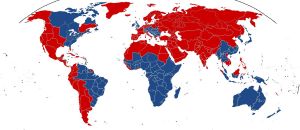Carquake
Carquake refers to two major international automotive crises during the 20th century which caused mass closing of automotive manufacturers and redistribution of market shares.
The First Carquake
During the 1940’s the world suffered from the Second Great War. Automotive manufacturers were forced by their national governments (mostly in Europe, less so in America) to convert to military purposes. In a few years mass private car production was halted in most countries. Exceptions were the NAL, Louisianne (neither of which were affected directly by warfare) and the Federated Kingdoms, but here mass production became a mere shadow of what it was during the Interbellum period. These three countries combined manufactured nearly all private cars in the world during this time.
Across Europe, and to a much smaller extent in China and Japan, many manufacturers were simply obliterated by total warfare. As former car factories now produced tanks, airplanes and all sorts of weapons they became major military targets and many were heavily bombed.
The wars ended in 1949. Much of Europe, China and Japan (which suffered a civil war) were in ruins. While some automotive manufacturers were back on business, firstly with pre-war designs, many didn’t. Some remained in military business such as Daimler from England, itself already a subsidiary of Enfield Small Arms (ESA) or Aero from Bohemia, which abandoned the production of cars to fully become an aircraft maker. Others were completely destroyed by warfare and ceased to exist, like Balti from Livonia.
Over half of the automotive brands in Europe disappeared during the 1940’s, either because they ceased to exist or moved to other businesses. This unprecedented mass extinction of car makers was called the "First Carquake" by automotive historians.
Several pre-war luxury brands, such as ALFA Lorena (from Italy) or Ti Frojta Motorverki (from Bohemia), returned to the automotive business but moved down-market in order to survive. During the post-war years many new models of small, cheap people’s cars appeared, some of the most notable being the Volkswagen Type 1 and the Frojt Egg Car. These became icons of the reconstruction of Europe.
Despite the fact that car makers from Louisianne and the NAL were by far the most powerful in the business by then, they missed the chance to enter strong into the recovering European car market as they kept producing large cars, hardly what an average European driver would need in a ruined continent. It was also a hard time for luxury brands as several governments taxed up-market cars.
The Second Carquake
By the late 1950’s the worldwide automotive industry was already rather strong. As reconstruction went by many families already owned a car in richer countries, and the number of trucks and buses grew dramatically.
According to their country of origin vehicles were made left-hand drive (LHD) for driving in right-hand traffic (RHT) or right-hand drive (RHD) for driving in left-hand traffic (LHT). Despite different driving configurations, all countries by then accepted imported vehicles with both configurations.
The increasing traffic during this period started to cause many accidents, partially explained by the lack of drivers’ visibility on wrong-hand drive configuration vehicles.
As a matter of traffic safety, in 1958 English government banned the import of LHD vehicles and gave a maximum of ten years to scrap the remaing LHD cars. Only LHD tourists’ cars would be allowed to be driven on English roads. Scottish and Kemrese governments soon followed with similar measures.
Although initially such a decision had good intentions, it seemed to many an act of protectionism against North German, French and Italian car imports. During the next few years strict homologation laws officially based on traffic safety (but often coming from a background of protectionism) were passed as a chain reaction across the world.
As at that time it was considered too costy to produce cars in both RHD and LHD configurations, brands from left-hand traffic countries withdrew from right-hand countries and vice versa, causing a massive redistribution of market shares worldwide. This turmoil became known as the "Second Carquake", which lasted between 1958 and 1965. There is still much debate among historians as to whether or not it was an international trade war between the major industrial nations.
Many brands lost their major exporting markets. While major car makers (usually from countries of origin with large enough domestic markets) were able to survive, many small and medium makers didn’t. Among the medium sized bankrupted companies Škóta (largest car maker from Bohemia), ALFA Lorena (second largest car maker from Italy) and Hispano-Helvetica (from Aragon) became the most famous. Ti Frojta Motorverki survived thanks to its unique driving configuration: steering wheel in the middle of the dashboard which allowed them to be used in all driving hand configurations.
Until the second half of the 1960’s, when larger car makers started to make vehicles in both LHD and RHD configurations, major brands from right-hand traffic countries, such as Adam Opel, Volkswagen, SIAT (Societat Ibèrica d'Automòbils de Turisme/Sociedat Ibérica de Automóbiles de Turismo) or Panhard & Levassor abandoned left-hand traffic countries while Mercedes Benz and the myriad brands from automotive groups English Leyland and Rootes Motors withdrew from right-hand traffic countries. Ironically countries from the Commonwealth of Nations (especially Australasia and the NAL) got rid of many of the mainland European and Louisiannan competitors but the void left, especially on down-market level, was soon filled by a horde of Japanese-made cars at a time when Japan (a left-hand traffic country) was becoming an emerging automotive power.


